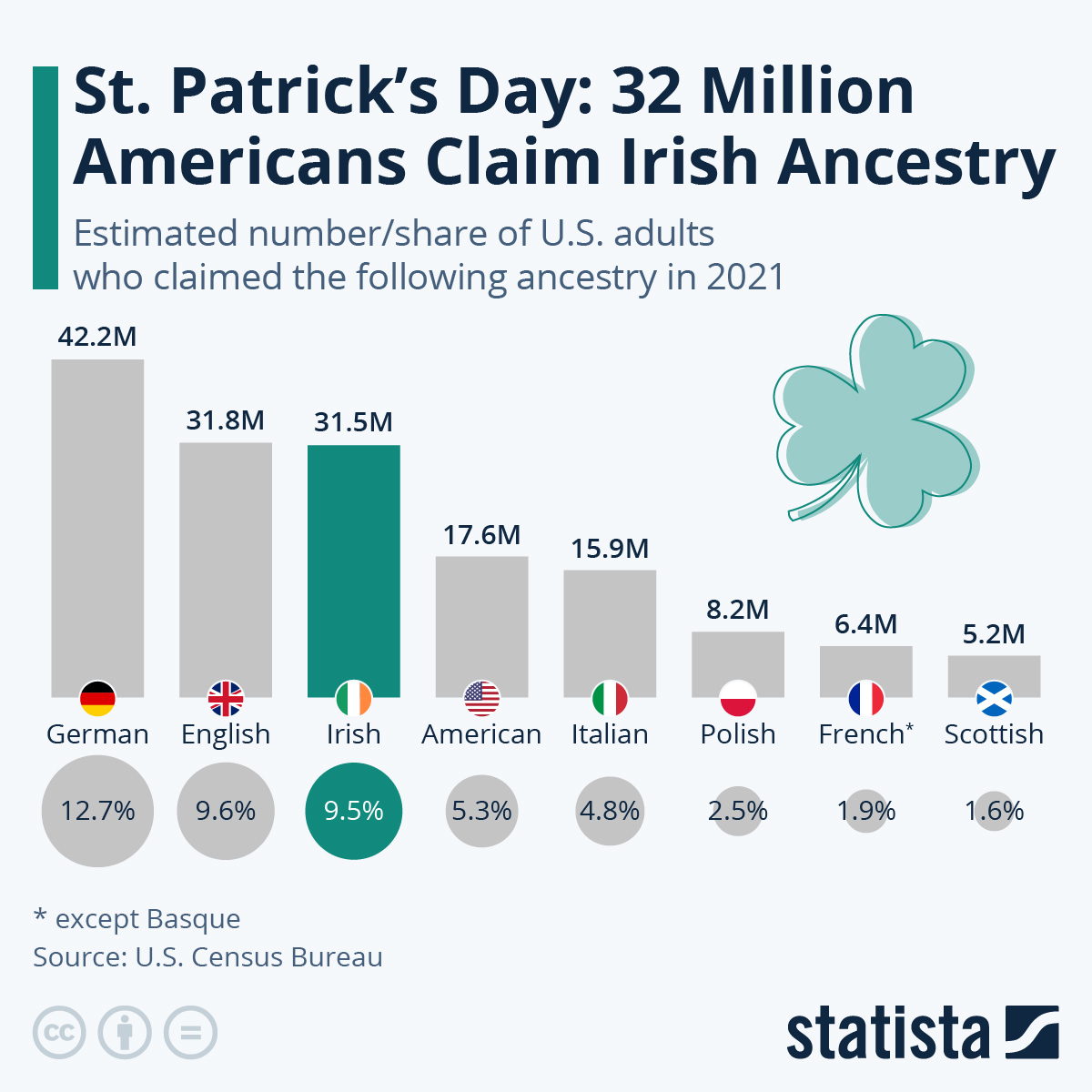Federal employees could add St. Patrick’s Day to their list of paid holidays if a new bill were to become law. That is not likely with the number of federal holidays being proposed in Congress to honor various populations in our country. But, with a large percentage of Americans claiming Irish ancestry, it is still a popular holiday.
The St. Patrick’s Day Act (H.R. 1625) was introduced by Congressman Brian Fitzpatrick (R-PA). It would make St. Patrick’s Day a federal holiday. According to data from the U.S. Census Bureau, some 31.5 million Americans claimed Irish ancestry in 2021, accounting for 9.5 percent of the population.
 You will find more infographics at Statista
You will find more infographics at Statista
Fitzpatrick said in a statement:
St. Patrick’s Day commemorates the rich history and fighting spirit of the Irish people – including nearly 2 million in Pennsylvania – and the countless contributions that generations of Irish Americans have made to our nation. As a descendant of Irish immigrants and a friend of Ireland, I am proud to introduce this bipartisan legislation to properly recognize St. Patrick’s Day as a federal holiday.
What is St. Patrick’s Day?
St. Patrick’s Day is celebrated on March 17 each year in Ireland to honor the death of Saint Patrick. The holiday has been celebrated for the past 1,000 years.
Saint Patrick died in the fifth century. Oddly enough, he was British, not Irish. He is believed to have died on March 17, around the year 460.
According to Biography.com, he was captured by Irish pirates and sold into slavery in Ireland at the age of 16. He became a Christian while enslaved, believing that the tribulation was a test of his faith by God.
After about six years, he escaped and ended up in France where he entered the priesthood. He eventually returned to Ireland as a missionary to spread the gospel of Christ to others.
As a Christian missionary, he established monasteries, churches, and schools.
The holiday in St. Patrick’s honor was first celebrated in 1631 when a feast was established in his honor. In the 1700s, the holiday began to become more popular because it was celebrated during Lent, which gave Christians a day off from abstinence leading up to Easter.
Irish immigrants in the United States helped popularize the holiday. Boston, a city with a large number of Irish immigrants, held its first St. Patrick’s Day parade in 1737, and New York held its first in 1762.
In 1798, green became the official color of the holiday. That was the year of the Irish Rebellion. Before that event, the official color associated with St. Patrick had been blue.
St. Patrick’s Day has become a global celebration of Irish culture, with parades, festivals, music, dancing, and drinking. The first St. Patrick’s Day parade was held in St. Augustine, Florida, in 1601 by a Spanish colony with an Irish vicar.
The first recorded parade in the American colonies was in New York City in 1762 when Irish soldiers in the British army marched to honor their saint and their homeland. The parade became an annual event and grew in size and popularity, attracting Irish immigrants and Americans of other backgrounds. Today, the New York parade is the largest and oldest in the world, with about 150,000 participants and millions of spectators.
Despite its popularity and significance, St. Patrick’s Day is not a federal holiday in the United States. This means federal employees do not receive the day off or holiday pay. Congress establishes federal holidays, and there has not been enough support or demand for making St. Patrick’s Day a federal holiday.
Growing List of Holidays for Federal Employees
Federal employees currently have 11 standard paid federal holidays. This number grew in 2021 when a new law established Juneteenth as a federal holiday.
In some years, federal employees get additional paid holidays, such as an extra day off at Christmas if a president grants one, or federal employees in the Washington, DC area get a day off for inauguration following a presidential election. 2021 was one such year as denoted in the list of 2021 federal holidays when inauguration day was held on January 20, 2021.
If other recent legislative proposals were to become law eventually, federal employees could have as many as 18 paid holidays in a typical year. In addition to St. Patrick’s Day, among the recent proposals in Congress to create new federal holidays are:
The Cost of Federal Holidays
Holidays always sound great; people like getting a day off from work, and politicians like to use the allure of giving free things to voters to curry political favor. However, federal holidays also come with a significant financial cost.
The total cost to taxpayers for each federal holiday is about $850 million. In reality, it is probably higher because that figure only includes federal agencies in the Executive Branch and does not include the postal service or the military.




